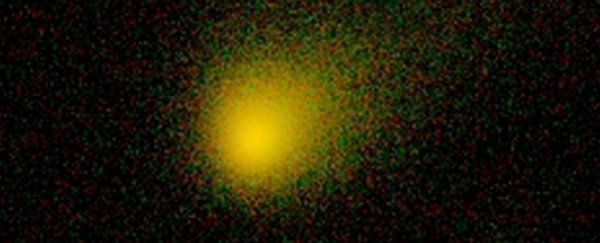A mysterious comet identified last year as only the second-ever known interstellar object in our Solar System inevitably prompted some big scientific questions. Chief among them: what, if anything, can it tell us about the hypothesised existence of extraterrestrial intelligence out there in space?
Well, if the object known as 2I/Borisov holds alien secrets, they're staying secrets for now. A recent announcement by scientists behind the Breakthrough Listen project reveals that scans of the comet reveal no signs of technosignatures we can identify that would indicate the presence of advanced, intelligent life.
The news, revealed by SETI (search for extraterrestrial intelligence) scientists at the annual meeting of the American Association for the Advancement of Science (AAAS) this month, highlights the almost overwhelming amount of unknowns and variables that challenge SETI researchers.
"If interstellar travel is possible, which we don't know, and if other civilisations are out there, which we don't know, and if they are motivated to build an interstellar probe, then some fraction greater than zero of the objects that are out there are artificial interstellar devices," explains astronomer Steve Croft UC Berkeley's SETI Research Centre.
"Just as we do with our measurements of transmitters on extrasolar planets, we want to put a limit on what that number is."
Scanning objects like 2I/Borisov to look for evidence of alien technology might seem like a decidedly sci-fi premise, but scientists are entirely open-minded when it comes to investigating these mysterious interstellar interlopers.
Before the world became aware of 2I/Borisov, another interstellar object, 'Oumuamua, made history, becoming the first-ever known interstellar visitor scientists had observed in our Solar System.
Amidst the excitement and curiosity, it didn't take long for some researchers to speculate as to whether 'Oumuamua could be an alien spacecraft of some description. Subsequent analyses suggested otherwise, though.
An attempt by SETI researchers to find alien technosignatures produced by 'Oumuamua – in the form of radio signals that might be emitted from the object – turned up nothing.
"We were looking for a signal that would prove that this object incorporates some technology – that it was of artificial origin," astrophysicist Gerry Harp from the SETI Institute explained in 2018.
"We didn't find any such emissions, despite a quite sensitive search."
Now, the same methods have also failed to find technosignatures coming from 2I/Borisov.
That doesn't necessarily mean there is no technology of any sort functioning on these interstellar objects; just that we can't identify evidence of the kind of electromagnetic radiation we would expect to see from Earth-based technology that emits radio signals.
Of course, 2I/Borisov, as intriguing as it may be, is just a tiny target in the much greater SETI hunt.
At the AAAS meeting this month, Breakthrough Listen researchers publicly released almost 2 petabytes of radio telescope survey data gleaned from observatories in the US and Australia. 2I/Borisov might not show any hits as yet, but there's no knowing for sure just what this giant data dump could reveal, which is why scientists are encouraging the public to help sift through said data.
"It is our hope that these data sets will reveal something new and interesting, be it other intelligent life in the Universe or an as-yet-undiscovered natural astronomical phenomenon," says Breakthrough Listen lead system administrator Matt Lebofsky.
In a new paper, one subset of the data provides a focus on radio emissions from 20 nearby star systems in what's known as the Earth Transit Zone, the region of the sky from which an observer would see the Earth transit the Sun.
"This is a unique geometry," lead researcher Sofia Sheikh from Penn State University explains.
"It is how we discovered other exoplanets, so it kind of makes sense to extrapolate and say that that might be how other intelligent species find planets, as well."
So far, there's no evidence of alien technosignatures in the data subset either, but there's no dampening the enthusiasm of the SETI community, especially as their own technological capabilities are only getting ever stronger.
The National Radio Astronomy Observatory (NRAO) simultaneously announced this month it will be collaborating with the SETI Institute to add SETI capabilities to NRAO radio telescopes.
Whether those new powers will finally help reveal the existence of a distant alien technology – or simply provide more examples of where ET isn't – it's impossible to say right now. But if the truth is out there, there's never been a better time to go looking for it.
